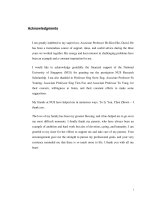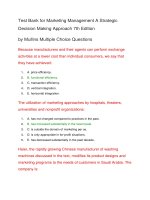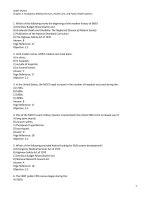Business statistics a decision making approach 6th edition ch10ppln
Bạn đang xem bản rút gọn của tài liệu. Xem và tải ngay bản đầy đủ của tài liệu tại đây (153.64 KB, 19 trang )
Business Statistics:
A Decision-Making Approach
6th Edition
Chapter 10
Hypothesis Tests for
One and Two Population
Variances
Business Statistics: A Decision-Making Approach, 6e © 2010 PrenticeHall, Inc.
Chap 10-1
Chapter Goals
After completing this chapter, you should be able to:
Formulate and complete hypothesis tests for a single
population variance
Find critical chi-square distribution values from the chisquare table
Formulate and complete hypothesis tests for the
difference between two population variances
Use the F table to find critical F values
Business Statistics: A Decision-Making Approach, 6e © 2010 PrenticeHall, Inc.
Chap 10-2
Hypothesis Tests for
Variances
Hypothesis Tests
for Variances
Tests for a Single
Population Variances
Tests for Two
Population Variances
Chi-Square test statistic
F test statistic
Business Statistics: A Decision-Making Approach, 6e © 2010 PrenticeHall, Inc.
Chap 10-3
Single Population
Hypothesis Tests for Variances
Tests for a Single
Population Variances
*
Chi-Square test statistic
Business Statistics: A Decision-Making Approach, 6e © 2010 PrenticeHall, Inc.
H0: σ2 = σ02
HA: σ2 ≠ σ02
Two tailed test
H0: σ2 ≥ σ02
HA: σ2 < σ02
Lower tail test
H0: σ2 ≤ σ02
HA: σ2 > σ02
Upper tail test
Chap 10-4
Chi-Square Test Statistic
Hypothesis Tests for Variances
The chi-squared test statistic for
a Single Population Variance is:
Tests for a Single
Population Variances
Chi-Square test statistic
(n − 1)s
χ =
σ2
2
*
2
where
χ2 = standardized chi-square variable
n = sample size
s2 = sample variance
σ2 = hypothesized variance
Business Statistics: A Decision-Making Approach, 6e © 2010 PrenticeHall, Inc.
Chap 10-5
The Chi-square Distribution
The chi-square distribution is a family of distributions, depending on degrees of freedom:
d.f. = n - 1
0 4 8 12 16 20 24 28
d.f. = 1
χ2
0 4 8 12 16 20 24 28
d.f. = 5
Business Statistics: A Decision-Making Approach, 6e © 2010 PrenticeHall, Inc.
χ2
0 4 8 12 16 20 24 28
χ2
d.f. = 15
Chap 10-6
Finding the Critical Value
The critical value,
chi-square table
, is found from the
χ 2α
Upper tail test:
H0: σ2 ≤ σ02
HA: σ2 > σ02
α
χ2
Do not reject H0
χ
Business Statistics: A Decision-Making Approach, 6e © 2010 PrenticeHall, Inc.
2
Reject H0
α
Chap 10-7
Example
A commercial freezer must hold the selected
temperature with little variation. Specifications call
for a standard deviation of no more than 4 degrees
(or variance of 16 degrees2). A sample of 16
freezers is tested and
yields a sample variance
of s2 = 24. Test to see
whether the standard
deviation specification
is exceeded. Use
α = .05
Business Statistics: A Decision-Making Approach, 6e © 2010 PrenticeHall, Inc.
Chap 10-8
Finding the Critical Value
The the chi-square table to find the critical value:
χ 2α = 24.9958 (α = .05 and 16 – 1 = 15 d.f.)
The test statistic is:
2
(n
−
1)s
(16 − 1)24
2
χ =
=
= 22.5
2
σ
16
Since 22.5 < 24.9958,
do not reject H0
There is not significant
evidence at the α = .05 level
that the standard deviation
specification is exceeded
α = .05
χ2
Do not reject H0
Business Statistics: A Decision-Making Approach, 6e © 2010 PrenticeHall, Inc.
χ 2α
Reject H0
= 24.9958
Chap 10-9
Lower Tail or Two Tailed
Chi-square Tests
Lower tail test:
Two tail test:
H0: σ2 ≥ σ02
HA: σ2 < σ02
H0: σ2 = σ02
HA: σ2 ≠ σ02
α
α/2
α/2
χ2
Reject
χ
Do not reject H0
2
χ2
Reject
1-α
Business Statistics: A Decision-Making Approach, 6e © 2010 PrenticeHall, Inc.
Do not
reject H0
χ 21-α/2
Reject
χ 2α/2
Chap 10-10
F Test for Difference in Two
Population Variances
Hypothesis Tests for Variances
H0: σ12 – σ22 = 0
HA: σ12 – σ22 ≠ 0
Two tailed test
H0: σ12 – σ22 ≥ 0
HA: σ12 – σ22 < 0
Lower tail test
H0: σ12 – σ22 ≤ 0
HA: σ12 – σ22 > 0
*
Tests for Two
Population Variances
F test statistic
Upper tail test
Business Statistics: A Decision-Making Approach, 6e © 2010 PrenticeHall, Inc.
Chap 10-11
F Test for Difference in Two
Population Variances
Hypothesis Tests for Variances
The F test statistic is:
(Place the
larger sample
variance in the
numerator)
2
1
2
2
s
F=
s
Tests for Two
Population Variances
*
s12
= Variance of Sample 1
n1 - 1 = numerator degrees of freedom
s22
= Variance of Sample 2
n2 - 1 = denominator degrees of freedom
Business Statistics: A Decision-Making Approach, 6e © 2010 PrenticeHall, Inc.
F test statistic
Chap 10-12
The F Distribution
The F critical value is found from the F table
The are two appropriate degrees of freedom:
numerator and denominator
s12
F= 2
s2
where
df1 = n1 – 1 ; df2 = n2 – 1
In the F table,
numerator degrees of freedom determine the row
denominator degrees of freedom determine the column
Business Statistics: A Decision-Making Approach, 6e © 2010 PrenticeHall, Inc.
Chap 10-13
Finding the Critical Value
H0: σ12 – σ22 ≥ 0
HA: σ12 – σ22 < 0
H0: σ12 – σ22 = 0
HA: σ12 – σ22 ≠ 0
H0: σ12 – σ22 ≤ 0
HA: σ12 – σ22 > 0
α
0
Do not
reject H0
Fα
Reject H0
α/2
F
rejection region
for a one-tail test is
s12
F = 2 > Fα
s2
0
Do not
reject H0
Fα/2
Reject H0
F
rejection region for
a two-tailed test is
s12
F = 2 > Fα / 2
s2
(when the larger sample variance in the numerator)
Business Statistics: A Decision-Making Approach, 6e © 2010 PrenticeHall, Inc.
Chap 10-14
F Test: An Example
You are a financial analyst for a brokerage firm. You want
to compare dividend yields between stocks listed on the
NYSE & NASDAQ. You collect the following data:
NYSE
NASDAQ
Number
2125
Mean
3.272.53
Std dev
1.301.16
Is there a difference in the
variances between the
NYSE
& NASDAQ at the α = 0.05 level?
Business Statistics: A Decision-Making Approach, 6e © 2010 PrenticeHall, Inc.
Chap 10-15
F Test: Example Solution
Form the hypothesis test:
H0: σ21 – σ22 = 0 (there is no difference between variances)
HA: σ21 – σ22 ≠ 0 (there is a difference between variances)
Find the F critical value for α = .05:
Numerator:
df1 = n1 – 1 = 21 – 1 = 20
Denominator:
df2 = n2 – 1 = 25 – 1 = 24
F.05/2, 20, 24 = 2.327
Business Statistics: A Decision-Making Approach, 6e © 2010 PrenticeHall, Inc.
Chap 10-16
F Test: Example Solution
(continued)
The test statistic is:
H0: σ12 – σ22 = 0
HA: σ12 – σ22 ≠ 0
s12 1.30 2
F= 2 =
= 1.256
2
s2 1.16
α/2 = .025
0
F = 1.256 is not greater than
the critical F value of 2.327, so
we do not reject H0
Conclusion: There is no evidence of a
difference in variances at α = .05
Business Statistics: A Decision-Making Approach, 6e © 2010 PrenticeHall, Inc.
Do not
reject H0
Reject H0
Fα/2
=2.327
Chap 10-17
Using EXCEL and PHStat
EXCEL
F test for two variances:
Tools | data analysis | F-test: two sample for variances
PHStat
Chi-square test for the variance:
PHStat | one-sample tests | chi-square test for the variance
F test for two variances:
PHStat | two-sample tests | F test for differences in two
variances
Business Statistics: A Decision-Making Approach, 6e © 2010 PrenticeHall, Inc.
Chap 10-18
Chapter Summary
Performed chi-square tests for the variance
Used the chi-square table to find chi-square critical values
Performed F tests for the difference between two population variances
Used the F table to find F critical values
Business Statistics: A Decision-Making Approach, 6e © 2010 PrenticeHall, Inc.
Chap 10-19









